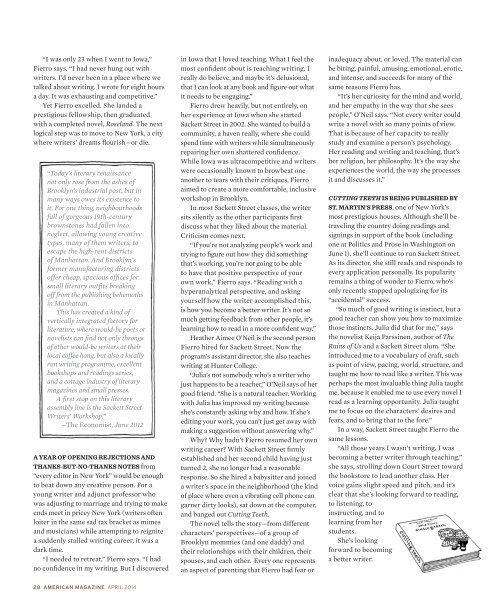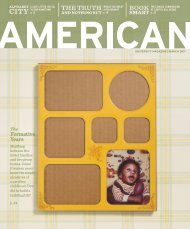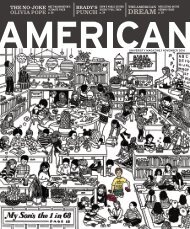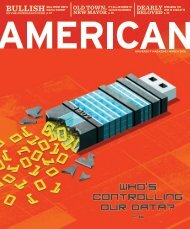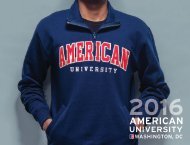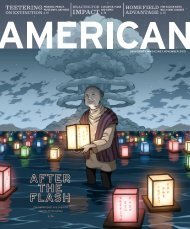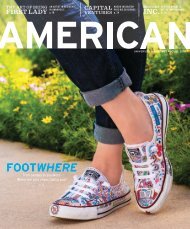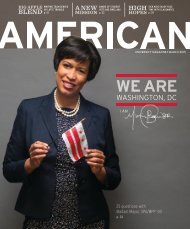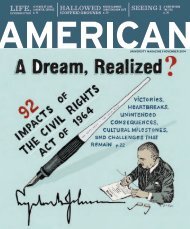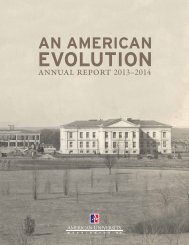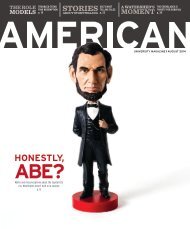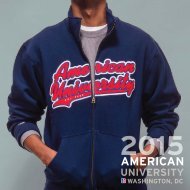American Magazine April 2014
American University is located in Washington, D.C., at the top of Embassy Row. Chartered by Congress in 1893 to serve the public interest and build the nation, the university educates active citizens who apply knowledge to the most pressing concerns facing the nation and world. Students engage with leading faculty experts and world leaders, learning how to create change and address issues including the global economic crisis, health care, human rights and justice, diversity, the environment and sustainability, immigration, journalism’s transformation, corporate governance, and governmental reform.
American University is located in Washington, D.C., at the top of Embassy Row. Chartered by Congress in 1893 to serve the public interest and build the nation, the university educates active citizens who apply knowledge to the most pressing concerns facing the nation and world.
Students engage with leading faculty experts and world leaders, learning how to create change and address issues including the global economic crisis, health care, human rights and justice, diversity, the environment and sustainability, immigration, journalism’s transformation, corporate governance, and governmental reform.
Create successful ePaper yourself
Turn your PDF publications into a flip-book with our unique Google optimized e-Paper software.
“I was only 23 when I went to Iowa,”<br />
Fierro says. “I had never hung out with<br />
writers. I’d never been in a place where we<br />
talked about writing. I wrote for eight hours<br />
a day. It was exhausting and competitive.”<br />
Yet Fierro excelled. She landed a<br />
prestigious fellowship, then graduated<br />
with a completed novel, Roseland. The next<br />
logical step was to move to New York, a city<br />
where writers’ dreams flourish—or die.<br />
“Today’s literary renaissance<br />
not only rose from the ashes of<br />
Brooklyn’s industrial past, but in<br />
many ways owes its existence to<br />
it. For one thing, neighbourhoods<br />
full of gorgeous 19th-century<br />
brownstones had fallen into<br />
neglect, allowing young creative<br />
types, many of them writers, to<br />
escape the high-rent districts<br />
of Manhattan. And Brooklyn’s<br />
former manufacturing districts<br />
offer cheap, spacious offices for<br />
small literary outfits breaking<br />
off from the publishing behemoths<br />
in Manhattan.<br />
This has created a kind of<br />
vertically integrated factory for<br />
literature, where would-be poets or<br />
novelists can find not only throngs<br />
of other would-be writers at their<br />
local coffee hang, but also a locally<br />
run writing programme, excellent<br />
bookshops and readings series,<br />
and a cottage industry of literary<br />
magazines and small presses.<br />
A first stop on this literary<br />
assembly line is the Sackett Street<br />
Writers’ Workshop.”<br />
—The Economist, June 2012<br />
A YEAR OF OPENING REJECTIONS AND<br />
THANKS-BUT-NO-THANKS NOTES from<br />
“every editor in New York” would be enough<br />
to beat down any creative person. For a<br />
young writer and adjunct professor who<br />
was adjusting to marriage and trying to make<br />
ends meet in pricey New York (writers often<br />
loiter in the same sad tax bracket as mimes<br />
and musicians) while attempting to reignite<br />
a suddenly stalled writing career, it was a<br />
dark time.<br />
“I needed to retreat,” Fierro says. “I had<br />
no confidence in my writing. But I discovered<br />
in Iowa that I loved teaching. What I feel the<br />
most confident about is teaching writing. I<br />
really do believe, and maybe it’s delusional,<br />
that I can look at any book and figure out what<br />
it needs to be engaging.”<br />
Fierro drew heavily, but not entirely, on<br />
her experience at Iowa when she started<br />
Sackett Street in 2002. She wanted to build a<br />
community, a haven really, where she could<br />
spend time with writers while simultaneously<br />
repairing her own shattered confidence.<br />
While Iowa was ultracompetitive and writers<br />
were occasionally known to browbeat one<br />
another to tears with their critiques, Fierro<br />
aimed to create a more comfortable, inclusive<br />
workshop in Brooklyn.<br />
In most Sackett Street classes, the writer<br />
sits silently as the other participants first<br />
discuss what they liked about the material.<br />
Criticism comes next.<br />
“If you’re not analyzing people’s work and<br />
trying to figure out how they did something<br />
that’s working, you’re not going to be able<br />
to have that positive perspective of your<br />
own work,” Fierro says. “Reading with a<br />
hyperanalytical perspective, and asking<br />
yourself how the writer accomplished this,<br />
is how you become a better writer. It’s not so<br />
much getting feedback from other people, it’s<br />
learning how to read in a more confident way.”<br />
Heather Aimee O’Neil is the second person<br />
Fierro hired for Sackett Street. Now the<br />
program’s assistant director, she also teaches<br />
writing at Hunter College.<br />
“Julia’s not somebody who’s a writer who<br />
just happens to be a teacher,” O’Neil says of her<br />
good friend. “She is a natural teacher. Working<br />
with Julia has improved my writing because<br />
she’s constantly asking why and how. If she’s<br />
editing your work, you can’t just get away with<br />
making a suggestion without answering why.”<br />
Why? Why hadn’t Fierro resumed her own<br />
writing career? With Sackett Street firmly<br />
established and her second child having just<br />
turned 2, she no longer had a reasonable<br />
response. So she hired a babysitter and joined<br />
a writer’s space in the neighborhood (the kind<br />
of place where even a vibrating cell phone can<br />
garner dirty looks), sat down at the computer,<br />
and banged out Cutting Teeth.<br />
The novel tells the story—from different<br />
characters’ perspectives—of a group of<br />
Brooklyn mommies (and one daddy) and<br />
their relationships with their children, their<br />
spouses, and each other. Every one represents<br />
an aspect of parenting that Fierro had fear or<br />
inadequacy about, or loved. The material can<br />
be biting, painful, amusing, emotional, erotic,<br />
and intense, and succeeds for many of the<br />
same reasons Fierro has.<br />
“It’s her curiosity for the mind and world,<br />
and her empathy in the way that she sees<br />
people,” O’Neil says. “Not every writer could<br />
write a novel with so many points of view.<br />
That is because of her capacity to really<br />
study and examine a person’s psychology.<br />
Her reading and writing and teaching, that’s<br />
her religion, her philosophy. It’s the way she<br />
experiences the world, the way she processes<br />
it and discusses it.”<br />
CUTTING TEETH IS BEING PUBLISHED BY<br />
ST. MARTIN’S PRESS, one of New York’s<br />
most prestigious houses. Although she’ll be<br />
traveling the country doing readings and<br />
signings in support of the book (including<br />
one at Politics and Prose in Washington on<br />
June 1), she’ll continue to run Sackett Street.<br />
As its director, she still reads and responds to<br />
every application personally. Its popularity<br />
remains a thing of wonder to Fierro, who’s<br />
only recently stopped apologizing for its<br />
“accidental” success.<br />
“So much of good writing is instinct, but a<br />
good teacher can show you how to maximize<br />
those instincts. Julia did that for me,” says<br />
the novelist Keija Parssinen, author of The<br />
Ruins of Us and a Sackett Street alum. “She<br />
introduced me to a vocabulary of craft, such<br />
as point of view, pacing, world, structure, and<br />
taught me how to read like a writer. This was<br />
perhaps the most invaluable thing Julia taught<br />
me, because it enabled me to use every novel I<br />
read as a learning opportunity. Julia taught<br />
me to focus on the characters’ desires and<br />
fears, and to bring that to the fore.”<br />
In a way, Sackett Street taught Fierro the<br />
same lessons.<br />
“All those years I wasn’t writing, I was<br />
becoming a better writer through teaching,”<br />
she says, strolling down Court Street toward<br />
the bookstore to lead another class. Her<br />
voice gains slight speed and pitch, and it’s<br />
clear that she’s looking forward to reading,<br />
to listening, to<br />
instructing, and to<br />
learning from her<br />
students.<br />
She’s looking<br />
forward to becoming<br />
a better writer.<br />
28 AMERICAN MAGAZINE APRIL <strong>2014</strong>


